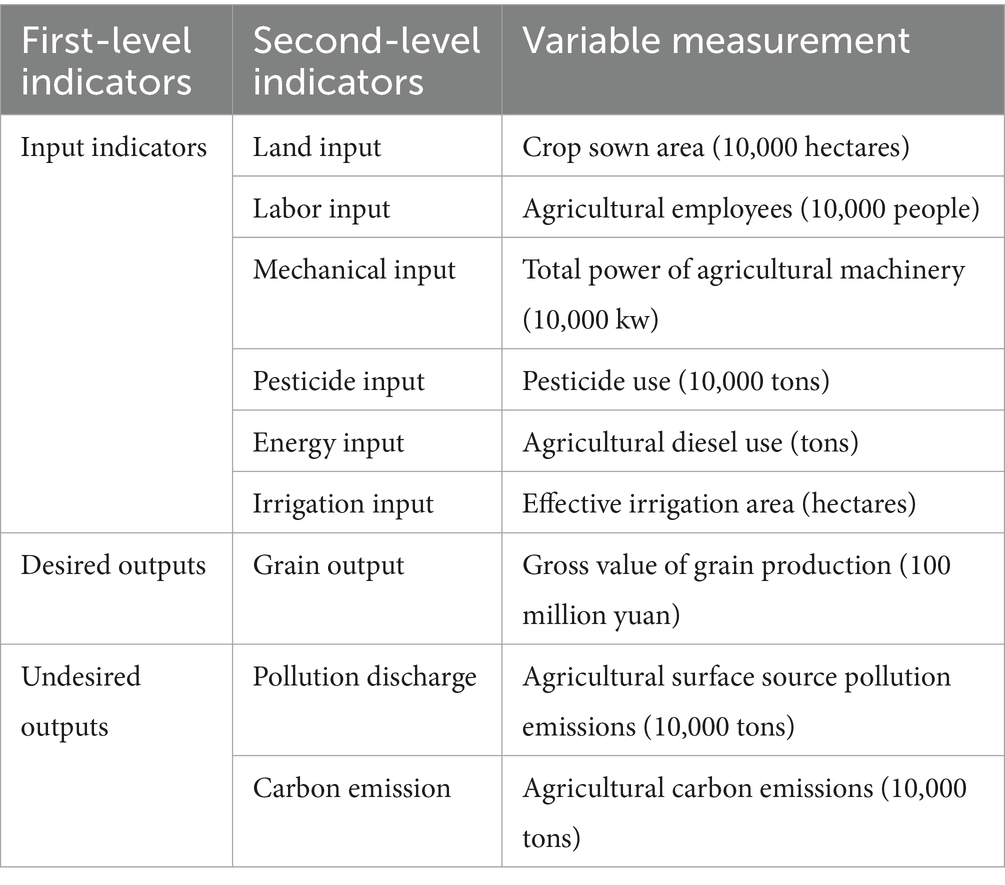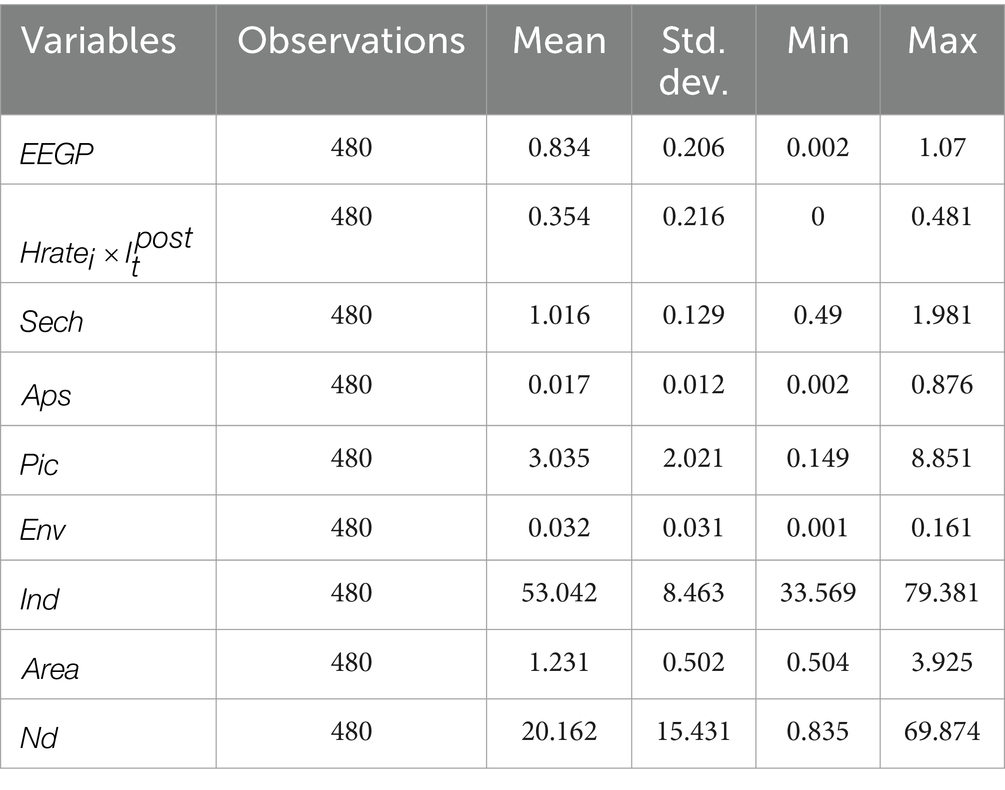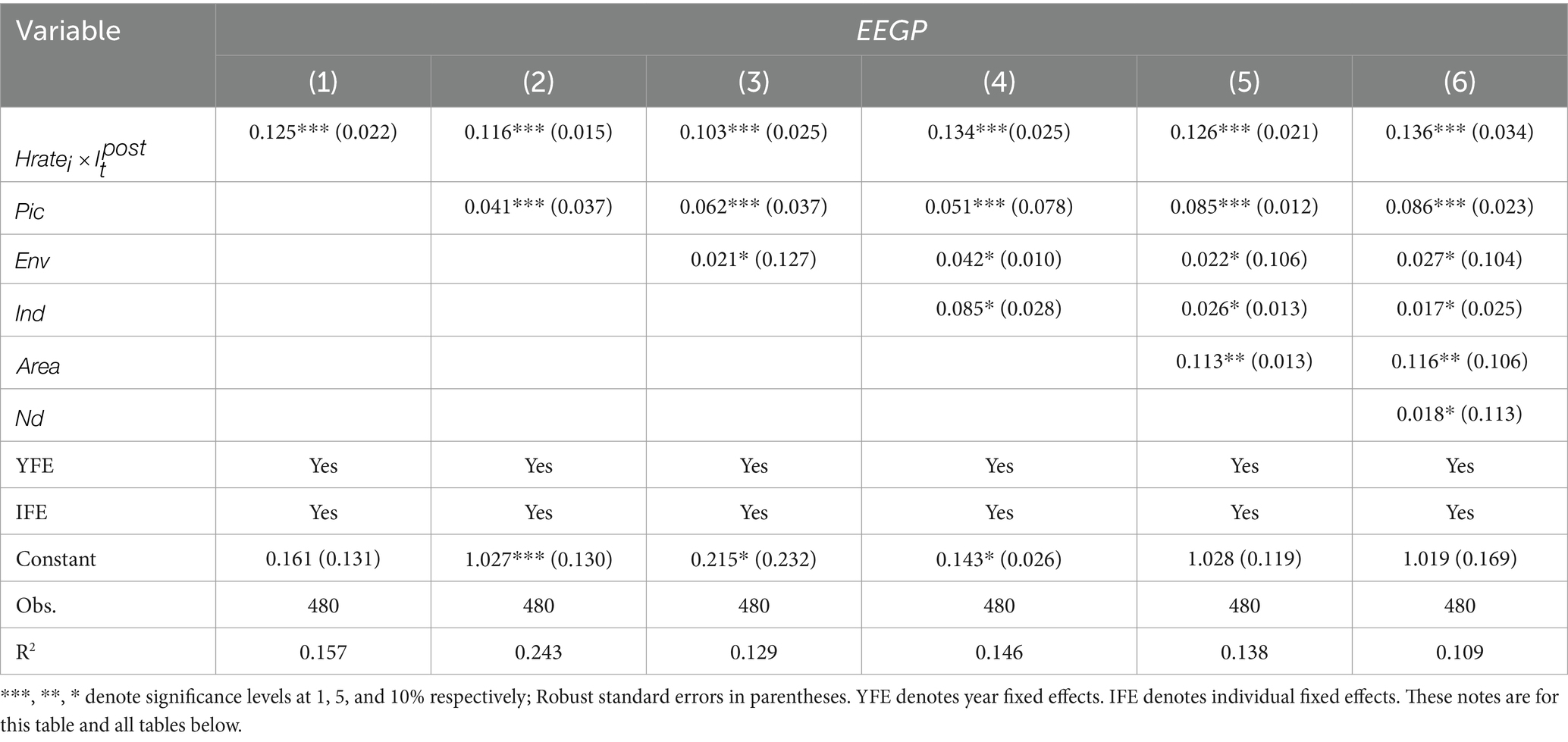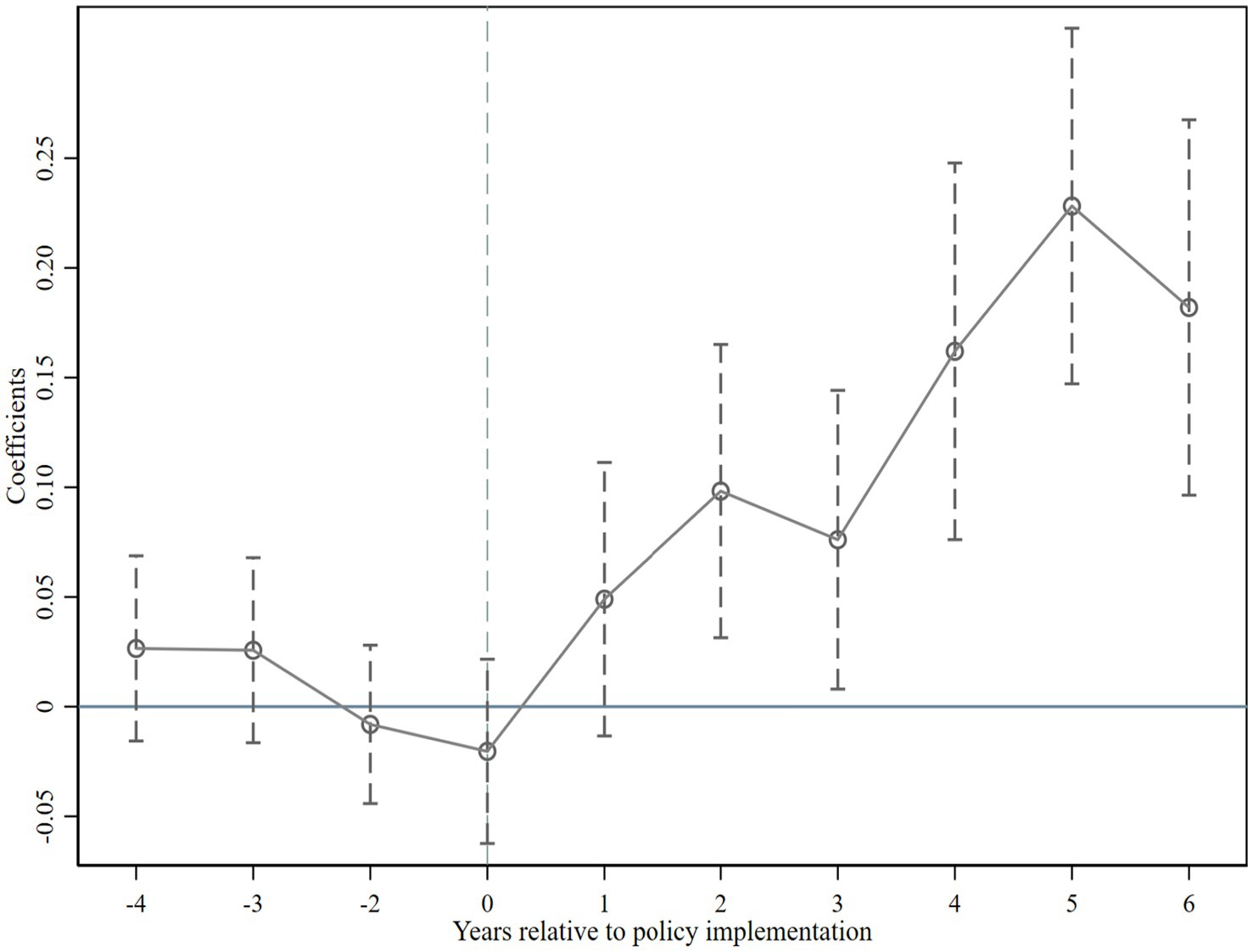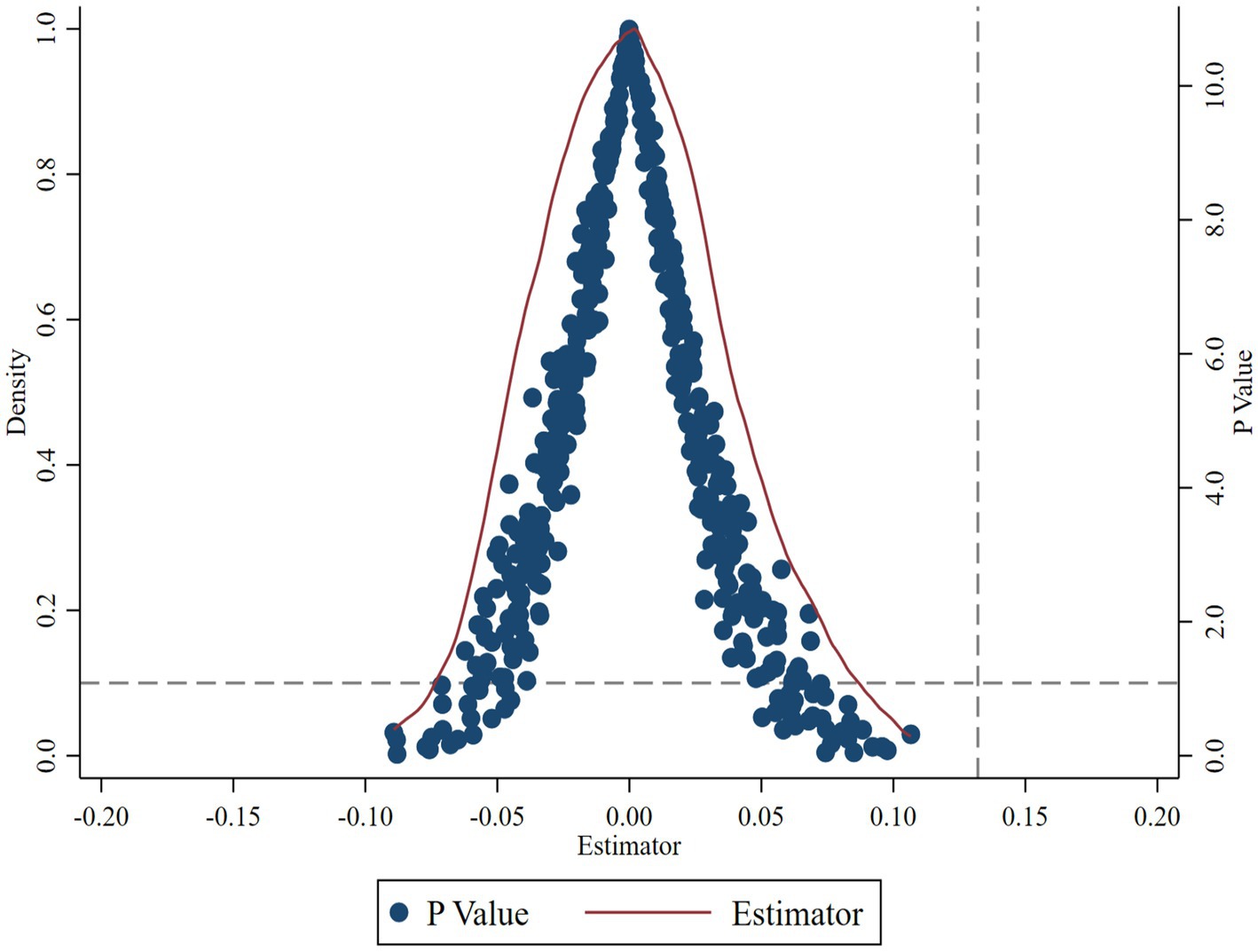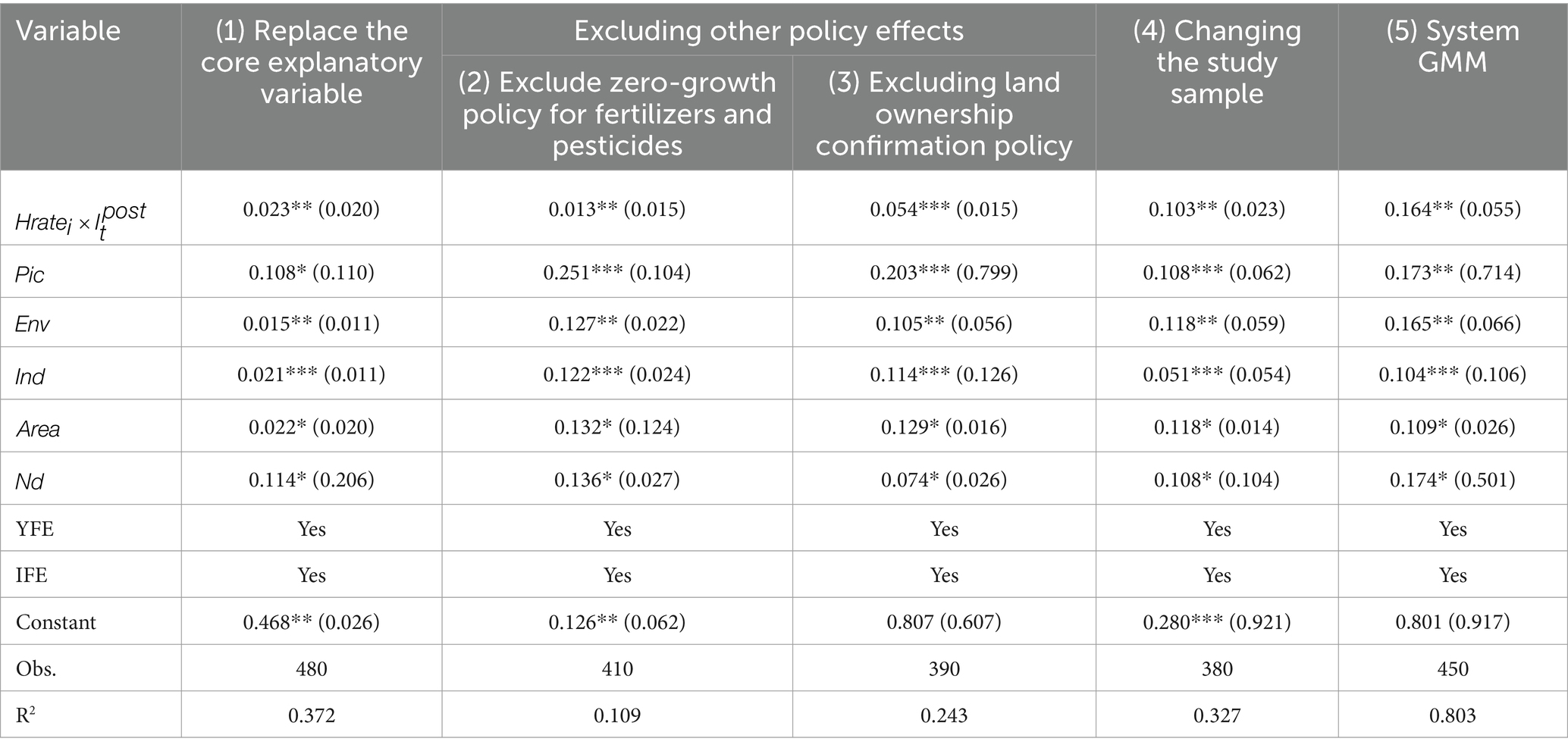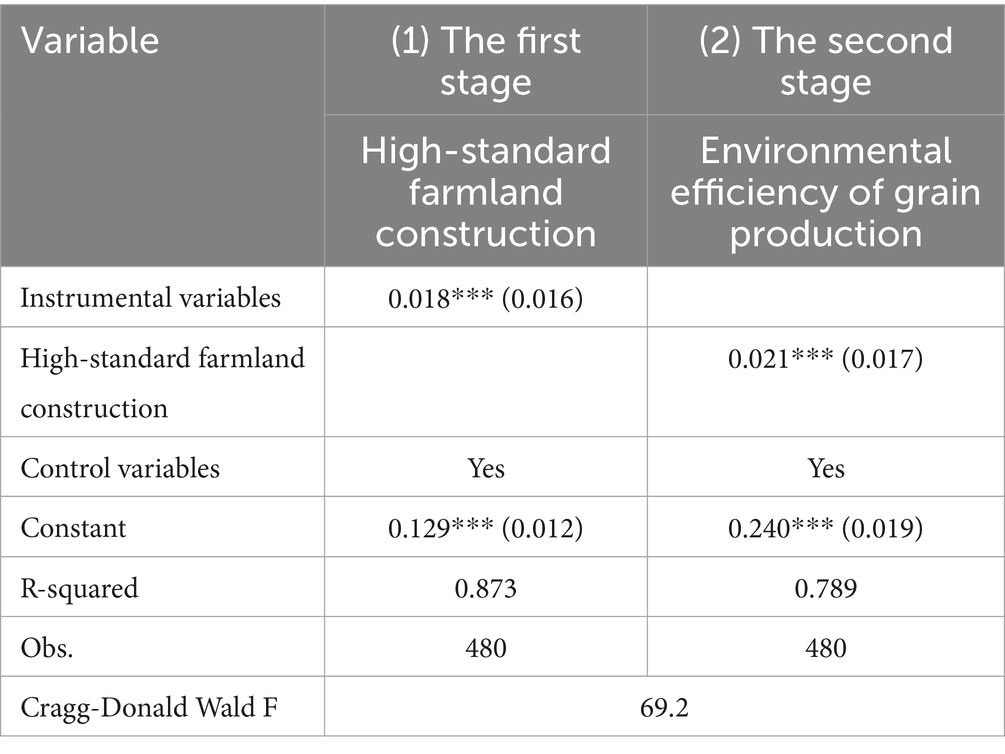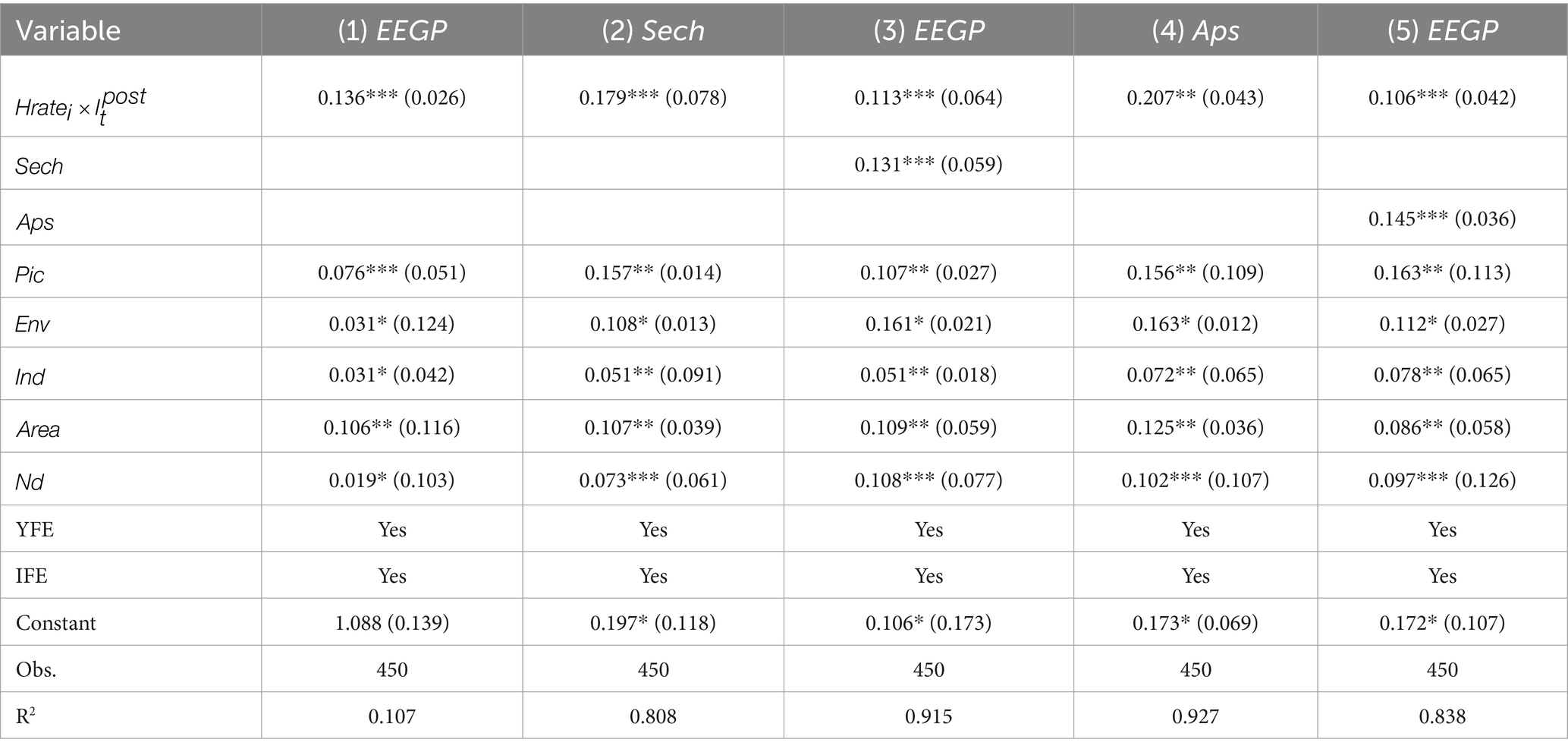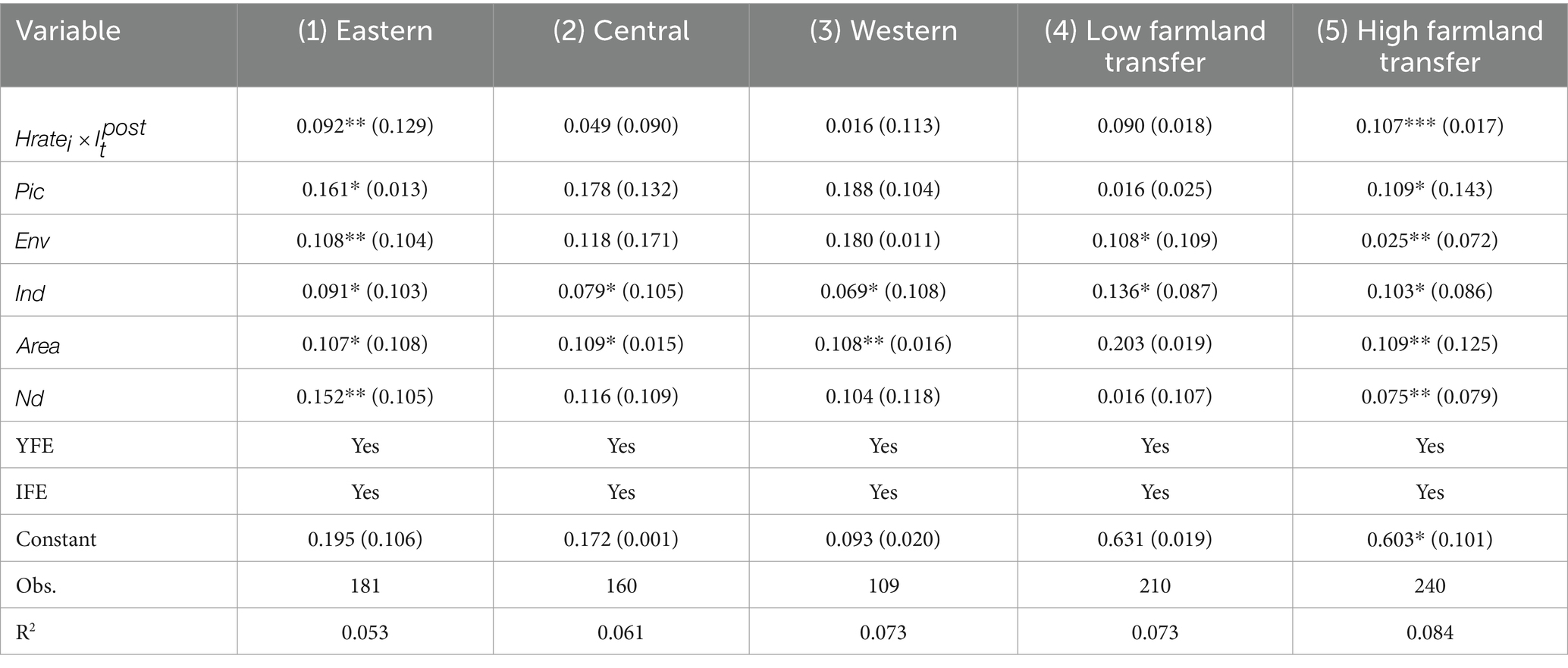- Jiangxi College of Foreign Studies, Nanchang, China
Introduction: With the global population growing and arable land becoming increasingly scarce, ensuring food security and promoting sustainable agricultural practices have become critical global priorities. This study investigates the environmental efficiency of grain production in China, focusing on the impact of the high-standard farmland construction (HSFC) policy.
Methods: Using panel data from 30 Chinese provinces from 2007 to 2022, the study employs a superefficient slack-based measure (SBM) model to assess the environmental efficiency of grain production, considering both desired and undesired outputs. A continuous difference-in-differences (DID) model is applied to examine the effects and mechanisms of the HSFC policy.
Results: The study finds that: (1) the overall environmental efficiency of grain production in China is improving, although the rate of improvement diminishes from the eastern to the central and western regions; (2) the HSFC policy positively influences environmental efficiency, especially in the eastern region and areas with significant land transfers; and (3) the policy enhances efficiency primarily through the promotion of larger-scale farming operations and improved agricultural services.
Discussion: The findings suggest that the HSFC policy plays a key role in improving the environmental efficiency of grain production, particularly in regions with more advanced agricultural infrastructure. These results emphasize the importance of tailoring agricultural policies to regional conditions. It is recommended that both Chinese and other developing nations customize their agricultural strategies to ensure grain security and foster sustainable agricultural development.
1 Introduction
Grain serves as the cornerstone for human survival, societal harmony, and national security. Ensuring grain security and fostering sustainable agricultural development are pivotal for the stability and prosperity of economies worldwide (Conceiçao et al., 2016). In recent years, China and other developing nations have faced significant challenges in agricultural production, not only due to shrinking arable land but also the deterioration of land quality and structural shifts in agriculture. These factors, combined with the increasing non-grain use of arable land, have contributed to diminished agricultural capacity and posed growing threats to food security. The resulting pressures on environmental sustainability, including resource depletion and pollution, further complicate the management of agricultural systems (Chen et al., 2023; Guan et al., 2023; Zhang H. X. et al., 2023; Zhang X. X. et al., 2023; Zhang Y. N. et al., 2023; Zhang Z. et al., 2023). Economic growth in China has exacerbated agricultural surface pollution, exemplified by the widespread application of chemical fertilizers resulting in environmental degradation (Zhang H. X. et al., 2023; Zhang X. X. et al., 2023; Zhang Y. N. et al., 2023; Zhang Z. et al., 2023; Liu and Ren, 2023; Wang J. T. et al., 2023; Yang et al., 2023). For instance, China’s yearly application of chemical fertilizers surpasses 59.841 million tons, contributing significantly to environmental harm. Agricultural activities are also major contributors to water pollution, with a substantial portion of dissolved inorganic nitrogen in rivers originating from agricultural sources (Wu et al., 2011). As China grapples with the dual challenges of food security and environmental sustainability, the government has implemented various agricultural policies, notably the development of high-standard farmland. This initiative, launched in 2011 as part of the “storing grain in the land” strategy, aims to create farmland with high and consistent crop yields and efficient management practices. By consolidating small plots into larger, continuous fields through techniques like “merging small fields with large fields” and “plot swapping,” the policy aims to enhance agricultural input efficiency, including the judicious use of chemical fertilizers, and mitigate carbon emissions. Despite its significance, there remains a dearth of comprehensive studies examining the policy’s actual effect on the environmental performance of grain production. Thus, the imperative moving forward is to strike a balance between ecological preservation and grain security, ensuring the harmonious and lasting advancement of agricultural production alongside environmental conservation.
The environmental efficiency of grain production is pivotal for minimizing resource utilization and environmental pollution while ensuring high yields and quality, serving as a crucial metric for assessing resource utilization efficiency and environmental impact (Xu et al., 2021; Liu and Chen, 2007). Research on grain production efficiency primarily revolves around its measurement and influencing factors. Traditionally, scholars have employed conventional efficiency measurement methods, constructing evaluation index systems focusing on input–output factors such as labor, land, machinery, and output, often overlooking environmental pollution generated during grain production (Song and Chen, 2019; Wang et al., 2019). However, as China’s rural economy evolves, the escalating environmental pollution in grain production has prompted scholars to consider the impact of environmental factors in efficiency assessments (Lin et al., 2023; Galeana-Pizaña et al., 2018). Yet, there’s no consensus on whether environmental factors should be treated as input factors or “undesirable” outputs (Li et al., 2022; Tian and Wang, 2016). Studies on factors influencing environmental efficiency in grain production can be categorized into micro and macro levels. Micro-level determinants focus on the production behavior of individual entities, particularly farmers, whose adjustments in production input factors significantly affect environmental efficiency (Wang et al., 2018; Wang Z. P. et al., 2023; Sun and Li, 2021). Meanwhile, macroeconomic development and external environmental factors also exert influence. Macro factors encompass urbanization levels, rural economic development, financial support for agricultural policies, and changes in food cultivation structure, all of which impact resource allocation, technological advancements, and production efficiency, thereby influencing environmental efficiency in food production (Zhang et al., 2022; Wang et al., 2019; Zhang H. X. et al., 2023; Zhang X. X. et al., 2023; Zhang Y. N. et al., 2023; Zhang Z. et al., 2023). International studies on environmental efficiency, particularly in the context of agricultural policy, offer valuable insights. Research within the European Union’s Common Agricultural Policy (CAP) highlights similar challenges related to environmental efficiency, where policies focused on land use consolidation and technology adoption aim to reduce environmental harm and increase sustainability. Comparisons with these international frameworks enrich the understanding of the HSFC policy’s role in improving environmental efficiency. For instance, the EU has integrated ecological service trade-offs and economies of scale within its policy structure, which is conceptually aligned with our study’s exploration of the HSFC policy’s impact on ecological balance and efficiency improvements.
In the realm of land consolidation research, scholars have directed their attention towards exploring the effects of such consolidation on climate, ecological environments, and rural revitalization (Zhou and Cao, 2020; Zhou et al., 2020; Li et al., 2021; Huang and Xiao, 2023). Specifically regarding the high-standard agricultural construction policy, studies have delved into its ecological and environmental impacts, its role in boosting grain production, and its effects on poverty alleviation (Li et al., 2023; Zhu et al., 2023; Pu et al., 2019; Gong et al., 2023; Ye et al., 2023; Peng et al., 2022). For instance, Li et al. (2023) utilized a continuous difference-in-difference (DID) model to evaluate the agricultural carbon emission reduction effect of the HSFC policy, concluding its significant impact on carbon emissions reduction. Zhu et al. (2023) conducted a quantitative analysis of four ecosystem services—habitat maintenance, soil conservation, food supply, and landscape aesthetics—in response to the implementation of HSFC, identifying spatial differentiation characteristics in their change responses. Moreover, Peng et al. (2022) found that the policy promoting HSFC fosters farmers’ income growth by augmenting plot sizes and enhancing horizontal and layered division of work in agriculture.
In summary, prior research has provided valuable insights into rural land consolidation and the environmental efficiency of grain production. However, notable gaps persist. Firstly, existing studies have overlooked the analysis of exogenous policy variables, such as the construction of high-standard farmland, and their impact on the environmental efficiency of grain production. Secondly, while some scholars have considered environmental pollution in grain production, there’s no consensus on whether environmental factors should be treated as input factors or “undesirable” outputs. Lastly, there’s a dearth of research on the mechanisms underlying the impact of HSFC policy on the environmental efficiency of grain production. Hence, it remains crucial to investigate whether China’s HSFC policy can indeed enhance the environmental efficiency of grain production, particularly considering the heterogeneity across provinces in terms of agricultural resource endowment, geographical location, and economic base. These issues necessitate further exploration. To address these gaps, this paper employs provincial panel data spanning from 2007 to 2022 to gauge the environmental efficiency of grain production using the super-efficiency SBM model. Additionally, a continuous DID model is constructed to assess the impact of HSFC on the environmental efficiency of grain production and elucidate its internal mechanisms. This paper offers three main contributions: First of all, it integrates HSFC and the environmental efficiency of grain production within a unified research framework, employing the continuous DID method to evaluate the policy’s effect quantitatively. Secondly, the utilization of the continuous DID model enhances the accuracy of research conclusions by capturing more data variability and mitigating bias. Finally, the paper delves into the internal mechanisms and group heterogeneity of the policy’s impact, offering empirical insights to guide the formulation of regionally differentiated land regulation policies and enhance the environmental efficiency of grain production.
The rest of the paper is structured as follows: Section 2 outlines the theoretical analysis and research hypotheses. Section 3 details the empirical model used. Section 4 covers variable selection and the research data. Section 5 offers the empirical estimation results and their analysis. Section 6 discusses the mechanism analysis and heterogeneity testing. Finally, Section 7 concludes with a discussion.
2 Theoretical analyses and research hypotheses
China’s high-standard farmland construction policy, which began in 1988, initially focused on upgrading low- and medium-yield fields and improving agricultural infrastructure. With the increasing pressure on food security, the central government put forward the concept of high-standard farmland construction in 2004 and began pilot projects. In 2011, the “Standard for the Construction of High-standard Farmland (Trial)” was issued, marking that the construction of high-standard farmland has entered the stage of full implementation. The main measures of the policy include land leveling and consolidation, irrigation facilities construction, soil improvement, agricultural technology promotion, green agriculture promotion, infrastructure construction and strengthening supervision of the whole process. Together, these measures have promoted the construction of high-standard farmland, improved food production capacity and sustainable agricultural development.
Rural land consolidation has the effect of integrating land use elements, restructuring land use configurations, and optimizing land use functions and can significantly reduce agricultural environmental pollution (Yang et al., 2022; Yin et al., 2022). From an economic point of view, according to the theory of the economy of scale, at a certain level of technology, moderately enlarging the scale of agricultural operations can optimize the allocation of input factors, thus reducing production costs or increasing grain yields (Zhu et al., 2018). The construction of high-standard farmland includes the levelling of fields, the appropriate merging of fragmented agricultural holdings and the optimization of the layout of ditches and roads, which helps to consolidate the plots of arable land. Although the policy of HSFC has not changed the size of the original amount of arable land, it has improved the economy of scale at the plot level. A moderate scale of agricultural production leads to the intensive use of factors, and the reduction of agricultural inputs means the reduction of agricultural carbon emissions. First, from an ecological perspective, farmland remediation affects the trade-offs and synergies between ecosystem services. After farmland remediation, the trade-off between crop production and soil conservation is reduced, while the trade-offs between soil conservation and carbon storage, and between crop production and carbon storage, are increased. Second, topography is a key factor in soil erosion, with steeper slopes leading to higher erosion rates. The HSFC policy reduces soil erosion by leveling fields and improving the capacity of soil-related ecosystem services. Third, the construction of high-standard farmland improves irrigation and drainage conditions, which in turn reduces environmental pollution and carbon emissions. Improved irrigation systems lower agricultural environmental pollution, as irrigation is a major contributor to both pollution and carbon emissions. It can be seen that the policy of HSFC improves the environmental efficiency of grain production by exerting economic and environmental effects. Thus, research hypothesis H1 is proposed.
H1: The high standard farmland construction policy can significantly improve environmental efficiency of grain production.
The construction of high-standard farmland realizes the centralization of land management through land consolidation measures such as “small fields and large fields,” forming a situation in which the scale of agricultural management expands in tandem with the scale of the land parcel, and the management rights of the consolidated land are issued to farmers, thereby achieving income-generating poverty reduction effects (Peng et al., 2022). Agricultural surface pollution presents the characteristics of dispersion, concealment and uncertainty, etc. The decentralized operation mode needs to consume a large amount of pollution costs, while the construction of high-standard farmland makes the production centralized and operated on a large scale, and optimizes the multifunctional layout of land, so that the emission and treatment of agricultural surface pollution is both of the nature of economies of scale. In addition, the optimization of spatial layout caused by the policy of HSFC has led to the spatial accumulation of agricultural production and gained the benefits of division of labor, which facilitates the promotion and diffusion of green production technology among farmers. Land remediation leads to the expansion of plot size, creating conditions for mechanized fertilizer application and ploughing, so that the input of factors tends to be scientific and rationalized, thus improving the standardization and normalization of the application of production factors such as fertilizers, pesticides and films, and reducing the emission of pollution (Guo and Wang, 2023; Li and Song, 2023; Guo et al., 2020). It can be seen that the policy of constructing high-standard farmland generates economic and environmental effects by promoting the scale of agricultural operations, thereby improving the environmental efficiency of grain production.
H2: The HSFC policy can positively affect environmental efficiency of grain production by increasing the scale of agricultural operations.
The HSFC policy has effectively promoted the development of agricultural production services. Farmland consolidation enables improved land management through such land integration measures as “merging small fields into large fields,” expanding the scale of operations and the scale of plots simultaneously and granting the right to work consolidated land to farming households. Against the background of the nonagricultural transfer of labor and the weakening of rural human capital, the scale of agricultural operations is expanding, and the demand of agricultural operators for labor is gradually transformed into a demand for commercial agricultural services in the market, which effectively drives the development of agricultural production. At the same time, the renovation of farmland “suitable for mechanization” and the construction of water conservancy facilities have been carried out to effectively ensure that agricultural machinery is efficiently operated and that fields are efficiently drained and irrigated, thus improving agricultural production as an industry. Specifically, on the one hand, the development of service industries around agricultural production effectively introduces green production technology into agriculture. By outsourcing agricultural production to service organizations, farmers can adopt more kinds of green technology, such as those for soil testing and formula fertilizer application, those for deep improvements of farmland, and those for pest prevention and control. The application of these green technologies helps improve agricultural production efficiency (Liu et al., 2023; Zhang H. X. et al., 2023; Zhang X. X. et al., 2023; Zhang Y. N. et al., 2023; Zhang Z. et al., 2023). On the other hand, the agricultural production service industry effectively connects the production and sales markets for agricultural products, extends the agricultural industry chain, puts forward higher requirements for the quality of agricultural products, pushes farmers to produce green and pollution-free agricultural products, reduces the input of chemical fertilizers, pesticides and other chemicals, and further drives the environmental efficiency of grain production (Tang et al., 2023; Bai et al., 2023). Thus, research hypothesis H3 is proposed.
H3: The HSFC policy can enhance environmental efficiency of grain production by promoting the development of services for agricultural production.
The impact mechanism of the HSFC policy on the environmental efficiency of grain production is shown in Figure 1.
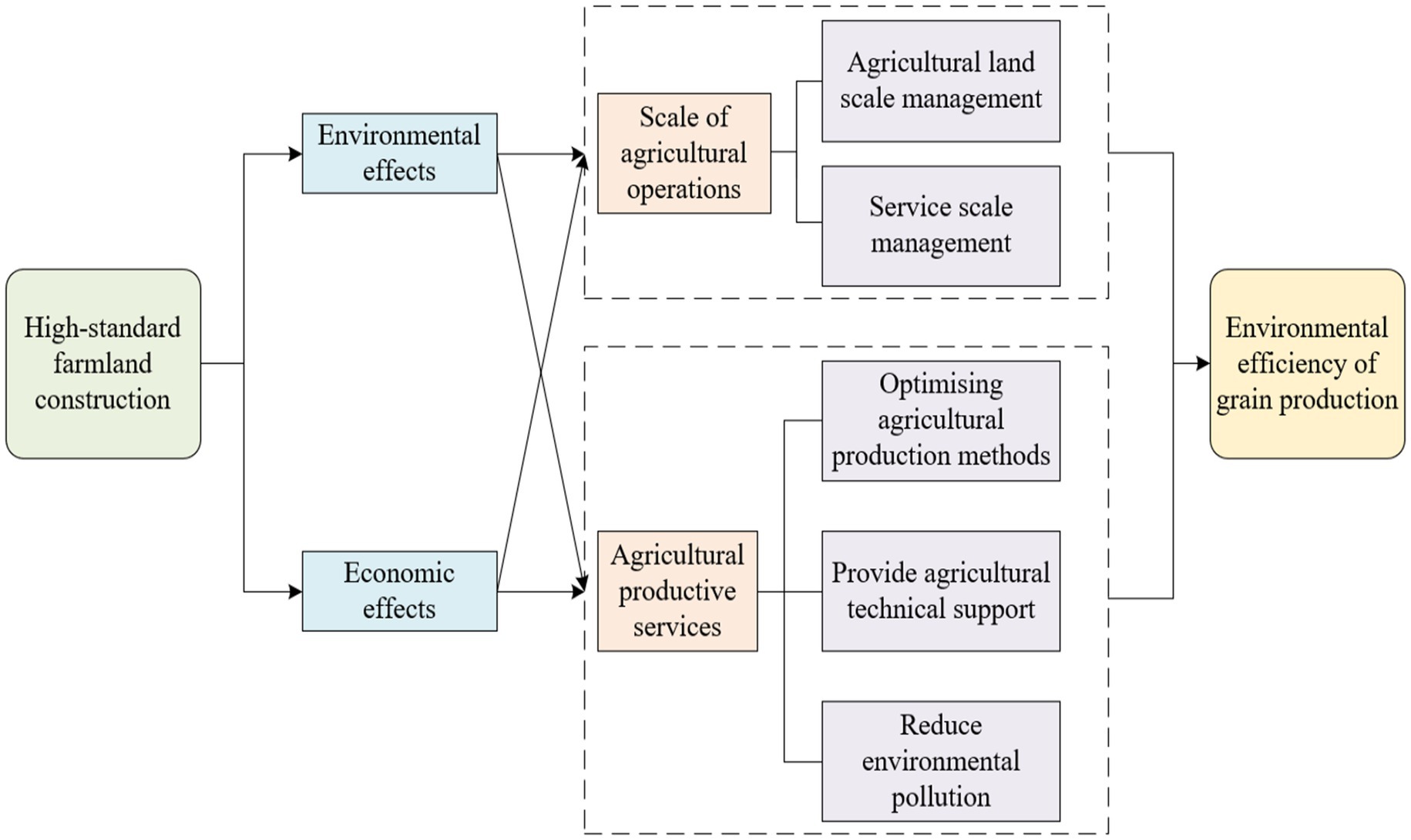
Figure 1. The impact mechanism of the HSFC policy on the environmental efficiency of grain production.
3 Methodology
3.1 Superefficient SBM modeling with undesired outputs
We assess the environmental efficiency of grain production using the superefficient SBM model, which incorporates undesired outputs. Currently, various methods exist for measuring environmental efficiency in grain production, with the data envelopment analysis (DEA) method developed by Charnes et al. (1979) being particularly prominent for evaluating the efficiency of multiple inputs and outputs. The traditional DEA model fails to consider the impact of ‘relaxation variables’ on efficiency values and does not account for technological changes that can simultaneously increase desired outputs and reduce undesired ones. To address this, Tone (2001) introduced a slack-based measure for environmental efficiency that incorporates these relaxation variables. In 2002, Tone further extended this with the SBM model and subsequently proposed the superefficient SBM model. This model builds on the traditional DEA framework by introducing a concept of superefficient value, effectively resolving the ranking issue among multiple efficient decision units.
We assume that there are decision units, each using inputs , desired outputs and undesired outputs, and the vector expression is . We define the matrices , , and as follows: , , and , where . We define the set of production possibilities as .
Referring to Tone (2002), the superefficient SBM model with undesired outputs can be derived as follows.
In Equation 1, is the value of the environmental efficiency of grain production; , and denote the slack variables for inputs, desired outputs and undesired outputs, respectively; and is a vector of nonnegative weights.
3.2 Benchmark regression model
The nationwide implementation of the HSFC policy in 2011 marked a phased approach across different regions, resulting in varying levels of progress. Consequently, the amount of high-standard farmland developed through land consolidation fluctuates across provinces during different phases of policy implementation. The core explanatory variable, ‘land consolidation area proportion,’ refers to the proportion of farmland that has undergone consolidation and is now categorized as high-standard farmland under the HSFC policy in each region. This variable captures the extent of exposure to the HSFC policy within each province and serves as a continuous indicator of policy implementation progress. These discrepancies in the implementation of HSFC across regions imply that land consolidation areas differ both within provinces before and after policy implementation, and between provinces at any given point during policy implementation. This variability provides the foundation for using the DID model to assess the policy’s impact on the environmental efficiency of grain production. Unlike the conventional DID model, which uses binary dummy variables to distinguish between experimental and control groups, this paper employs the continuous variable ‘land consolidation area proportion’ to differentiate between these groups. As a result, observations naturally fall into treatment groups (regions with higher proportions of renovated land) and control groups (regions with lower proportions of renovated land) based on the moment of policy implementation. This continuous DID model retains the core properties of the DID approach while capturing more variability in the data and reducing biases that could arise from arbitrarily defining treatment and control groups (Nunn and Qian, 2011).
To identify the impact of the policy on environmental efficiency of grain production, this paper regards the HSFC policy established in 2011 as a relatively exogenous condition in a quasinatural experiment and constructs the following benchmark regression model using the continuous DID method.
Where denotes province; denotes year; and denotes environmental efficiency of grain production. denotes the percentage of land consolidation area, and denotes a dummy variable identifying whether the policy has been implemented with in the year of policy implementation and the year after and before the policy is implemented. is a series of control variables. and denote the province fixed effect and time fixed effect, respectively. is a random disturbance term; is a constant term. and are parameters. denotes the net impact of the implementation of the HSFC policy on environmental efficiency of grain production, and the magnitude of the coefficient reflects the extent of the policy’s impact, which is the coefficient of interest in our empirical results.
3.3 Mediating mechanism
The mediating effect model was employed to scrutinize the mechanism through which the HSFC policy influences the environmental efficiency of grain production. Following the three-step method outlined by Baron and Kenny (1986), we assess whether the mediating variable exhibits a significant mediating effect between HSFC and the environmental efficiency of grain production. Equations 2–4 are utilized to examine the logical relationships among the HSFC policy, the mediating variables, and the environmental efficiency of grain production. The specific models are delineated below.
Where represents the mediating variables, i.e., the scale of agricultural operations and the development of agricultural productive services; , , , , , and are the parameters, is the random disturbance term, and the remaining variables are defined as described in Equation 2. The total effect of the policy is , the direct effect is , and the indirect effect, i.e., the mediating effect, is .
3.4 Parallel trend test and dynamic effects analysis model setting
To test whether the treatment and control groups have the same trend of change before the implementation of the high standard farmland construction policy, we extend Equation 2 and further construct a dynamic DID model to test whether the parallel trend assumption is satisfied. The dynamic DID model is set as follows.
In Equation 5, denotes the antecedent term for the th period of the implementation before the high standard farmland construction policy in province , and denotes the posterior term for the th period of the high standard farmland construction policy. If the coefficient corresponding to the antecedent term is not significant and the coefficient corresponding to the posterior term is significant or partially significant, it indicates that the parallel trend assumption is satisfied. is the intercept term, and the other variables are set consistent with equation (2).
4 Data and variables
4.1 Data sources
Considering the availability of data and unique resource endowment conditions, Hong Kong, Macao, Taiwan and the Tibet Autonomous Region of China are excluded from the scope of the study for the time being, and 30 provinces in mainland China are used as the decision-making units in this paper, with the time interval of 2007–2022. Among the raw data for each indicator, the agricultural labor input indicator of the agricultural working population draws from the CEIC database, the agricultural pesticide input indicators come from data in the China Rural Statistical Yearbook, the agricultural natural resource input and agricultural machinery input statistics come from the China Statistical Yearbook, and some of the missing data are supplemented by the China Agricultural Yearbook. The agricultural gross output value for the desired output indicator are taken from the China Statistical Yearbook, and to eliminate the influence of inflation, the price deflator is applied with 2007 as the base period. The undesired output indicator involves data from the China Rural Statistical Yearbook, and the remaining data for all items are from the China Statistical Yearbook. Some missing data are filled in by interpolation. In addition, to avoid the adverse effects of outliers, all data are winsorized at the 1 and 99% percentiles.
4.2 Variable selection and descriptive statistics
4.2.1 Explained variable
The explained variable is environmental efficiency of grain production, denoted as . According to the China Rural Statistical Yearbook, grains are identified as cereals, pulses and potatoes. In this paper, environmental factors are included in the traditional “input–output” indicator system of grain production efficiency. The input index includes inputs from land, agricultural labor, irrigation, mechanical power, pesticides, and energy. The desired output of the output index is measured by the gross value of grain production, while the undesirable outputs mainly include pollution and carbon emissions. Pollution emissions from agricultural surface sources are used to measure pollution emissions in grain production. Carbon emissions in grain production from grain production come from four main sources: pesticides, fertilizers, agricultural machinery power and agricultural irrigation. With reference to the literature Li et al. (2011), the formula for total carbon emissions as presented in Equation 6, is as follows:
In the above equation, represents the total carbon emission, denote the source of carbon emission, represents the carbon emission coefficient, which indicates the carbon emission intensity associated with each source. denotes the source of Class carbon emission. Table 1 shows the specific indicators.
4.2.2 Core explanatory variable
With reference to the study by Liang et al. (2021), the interaction term measuring the effects of the dummy variable of the proportion of land renovation area and the implementation year of the policy represents the core explanatory variable. The ratio of land rehabilitation area is the percentage of the area of low- and medium-yield fields and high-standard farmland in the total cultivated area. is a dummy variable for the point of time when the HSFC policy is implemented. Since the policy was instituted nationwide in 2011, is taken as 1 when ; otherwise, it is 0.
4.2.3 Mechanism variables
This study selects the scale efficiency of agricultural operations and the development of agricultural production services as mechanism variables. The DEA-Malmquist model is employed to compute total factor productivity, and the resulting scale efficiency index, which reflects the effectiveness of agricultural operations at scale, is referred to as . The growth of agricultural production services is represented by the ratio of the output value from the agriculture, forestry, livestock, and fishery sectors to the sown crop area, adjusted to 2007 base year prices, and is indicated by . This variable provides a broad measure of agricultural productivity, integrating the contributions of various sectors and reflecting the overall efficiency of agricultural production services.
4.2.4 Control variables
Drawing on prior research (Wang Z. P. et al., 2023; Zhang et al., 2022), five variables were chosen as control factors: the level of agricultural economic development, investments in environmental pollution mitigation, agricultural industry structure, grain cultivation area per worker, and natural disasters. Agricultural economic development is represented by the per capita agricultural added value, labeled as . Environmental pollution control investments are quantified as the percentage of GDP allocated to pollution mitigation, denoted as . The structure of the agricultural sector is measured by the ratio of agricultural output value to the combined output of agriculture, forestry, animal husbandry, and fisheries, abbreviated as . The grain cultivation area per laborer is calculated by dividing the total rural grain cultivation area by the number of workers in the primary industry, referred to as . Natural disasters are assessed by the ratio of the affected crop area to the total sown area, represented by .
Table 2 presents the summary statistics of the key variables.
5 Empirical result analysis
5.1 Analysis of measurement results of environmental efficiency of grain production
In this research, the superefficient SBM model incorporating undesired outputs was employed to assess the environmental efficiency of grain production across Chinese provinces from 2007 to 2022. Figure 2 illustrates the trend in the average value of China’s environmental efficiency of grain production over this period. As shown in Figure 2, the general trajectory of China’s environmental efficiency in grain production shows an upward fluctuation during the study period. To further capture the spatial and temporal variations in environmental efficiency, following the guidelines of the China Development and Reform Commission (NDRC), the 30 Chinese provinces were grouped into three regions—east, central, and west—with ratios of 11:10:9, respectively, and the yearly mean environmental efficiency of grain production for each region was computed. Specifically, the trend in environmental efficiency for the three major regions aligns broadly with the national pattern, but significant regional differences in efficiency levels exist. For most years, the central and western regions fall below the national average, indicating room for improvement, while the eastern region consistently exceeds the national average. This advantage in the east may stem from factors such as higher openness, rapid development, earlier adoption of agricultural modernization, stronger environmental protection awareness, and stricter pollution control. While the central region has made considerable progress, its agricultural modernization and intensification levels remain lower compared to the east, and its relatively weaker pollution control measures contribute to lower ecological efficiency. The western region, by contrast, faces limitations due to environmental and natural factors, with lower agricultural development contributing to reduced environmental efficiency in grain production.
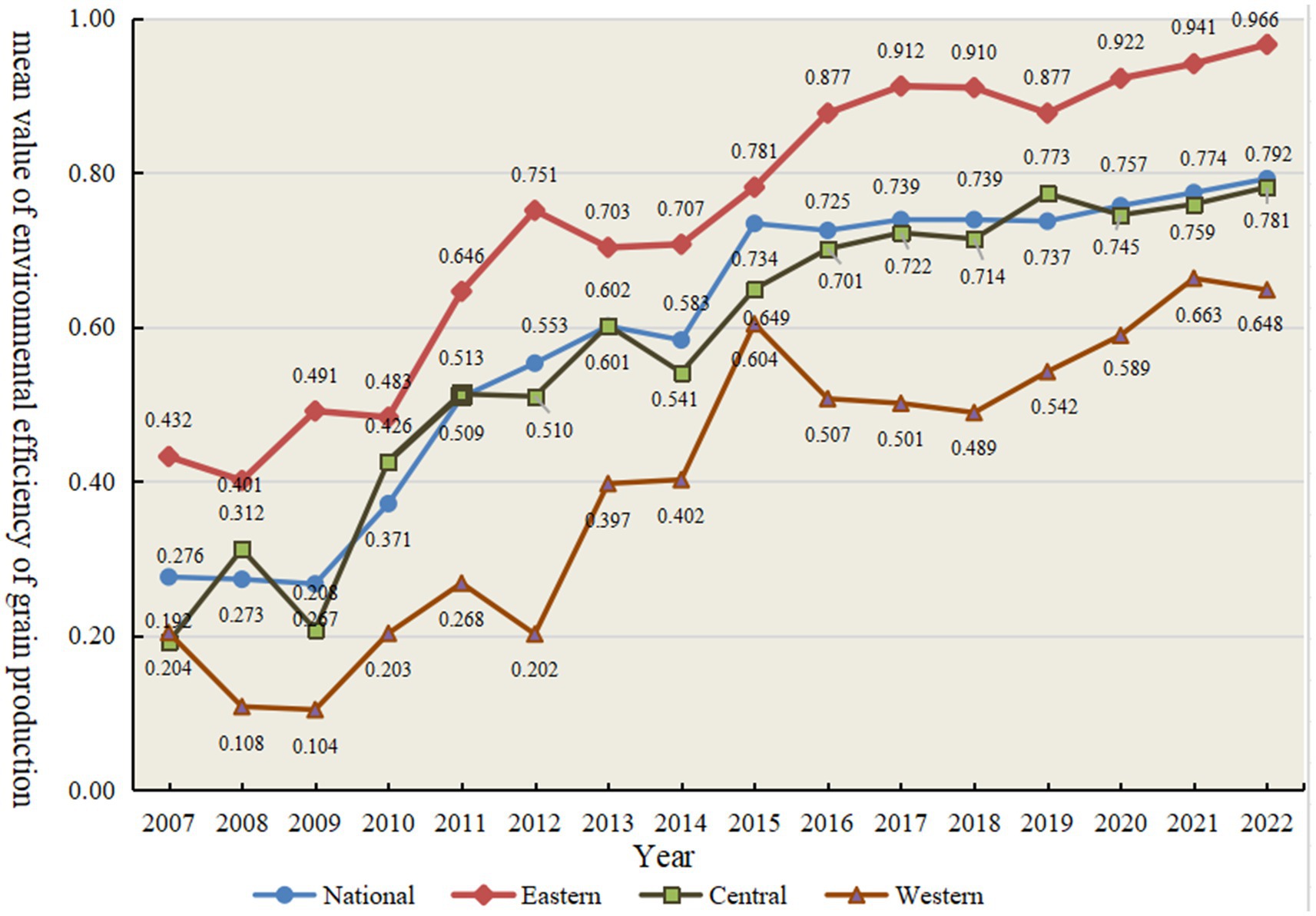
Figure 2. Trends in the mean value of environmental efficiency of grain production in China from 2007 to 2022.
5.2 Benchmark regression results
In this study, Equation 2 was applied to employ the continuous DID model to evaluate the effect of the HSFC policy on the environmental efficiency of grain production. The detailed regression outcomes are presented in Table 3. In Column (1) of Table 3, without incorporating any control variables, the interaction term has a coefficient of 0.125, which is statistically significant at the 1% level. As control variables influencing the environmental efficiency of grain production are incrementally introduced in Columns (2) through (6), the estimated coefficient of remains positive and significant at the 1% level. In Column (6), after including all control variables, the coefficient for is 0.136, suggesting that the implementation of the HSFC policy leads to an average improvement of approximately 13.6% in environmental efficiency, assuming other factors remain constant. This finding supports the notion that the HSFC policy enhances environmental efficiency in grain production, providing preliminary confirmation for research hypothesis H1.
5.3 Parallel trend test and dynamic effects analysis
The parallel trend test is a crucial condition for applying the difference-in-differences model, as it ensures no significant disparity between the treatment and control groups prior to policy implementation. In this study’s model, the parallel trend assumption uses 2011, the year the policy was introduced, as the reference point to confirm a similar trend in environmental efficiency changes between the treatment and control provinces before the high-standard farmland policy took effect. Figure 3 visually depicts the variation in the estimated coefficients of the HSFC policy within a 95% confidence interval. The results indicate that, before the policy was implemented, the estimated coefficients are mostly contained within 0 at the 95% confidence level, showing no significant difference. However, after the policy’s implementation, the estimated coefficients’ 95% confidence intervals largely exclude 0, indicating substantial differences in the post-implementation estimates and confirming the parallel trend assumption.
Based on the dynamic estimation results, it is evident that the impact of the HSFC policy gains statistical significance after 2013, signaling the onset of policy effects by the third year following its implementation. This suggests a delay in the enhancement of environmental efficiency within grain production brought about by the HSFC policy. This lag could be attributed to a lack of comprehensive support in the policy’s initial phase, such as limited investment, which made it challenging to observe tangible effects. As policy support improved, with increased funding and higher construction standards, the policy’s impact gradually became more noticeable. The estimated coefficients indicate that from 2013 onward, the influence of the HSFC policy grows progressively stronger.
5.4 Placebo test
To examine whether the conclusions of this paper may bias the estimates due to omitted variables, this paper randomly constructed a fictitious policy implementation time for each province, and randomly sets the treatment group and the control group for placebo test. As the “pseudo” treatment group is created randomly and is unlikely to significantly impact the dependent variable, its estimated coefficient is expected to be close to zero. In this paper, the random generation process is repeated 500 times, and the estimated coefficients and p-value distribution of the random generation treatment group are reported in Figure 4. The results show that the mean coefficient of is near 0 and far from the actual regression coefficient of 0.136, which is represented by the virtual vertical line in Figure 4. The actual regression coefficient is an outlier in the coefficient distribution of the placebo test. This indicates that the improvement of environmental efficiency of grain production is indeed the result of the implementation of the HSFC policy, and is not caused by other uncontrolled omitted variables.
5.5 Robustness test
5.5.1 Replacing the core explanatory variable
In this paper, the interaction term of agricultural comprehensive development input per unit of crop-sown area and the dummy variable of policy implementation year is used to replace for regression. A primary application of investments in comprehensive agricultural development involves implementing rural land management initiatives, such as improving low- and medium-yield farmland, building high-standard agricultural fields, and other related projects. These efforts encompass essential actions like soil enhancement, water resource management, forestry development, and more. Therefore, it is reasonable to use agricultural comprehensive development input as a substitute variable for the proportion of land consolidation area. The empirical results are shown in Column (1) of Table 4. is still significantly positive at the 5% level, and the results are consistent with the baseline regression results.
5.5.2 Excluding other policy effects
First, after the implementation of the HSFC policy, the Chinese Ministry of Agriculture proposed a zero-growth action policy for fertilizers and pesticides in 2015, which will inevitably have an impact on agricultural ecological efficiency. Therefore, the observations after 2015 were excluded, and the regression was performed again. Second, clear land property rights indicate that land rights are stable, and farmers will reduce short-term production out of their own interests, which has an impact on agricultural ecological efficiency. Therefore, the land ownership confirmation variable is included in the control variables to eliminate the influence of the land ownership confirmation policy. Columns (2) and (3) of Table 4 present the findings. The interaction coefficients are significantly positive at the levels of 5 and 1%, respectively, and the findings align with the baseline regression outcomes, confirming the robustness of this paper’s conclusions.
5.5.3 Changing the sample
Given the unique status and policy preferences associated with China’s centrally governed municipalities, this study re-calculates the results by excluding data from Beijing, Tianjin, Shanghai, and Chongqing. The outcomes are displayed in Column (4) of Table 4. The interaction term coefficient, , remains positive and statistically significant at the 5% level, aligning with the baseline regression findings.
5.5.4 Considering endogenous factors
From an intuitive point of view, the HSFC policy is an external factor, and the endogeneity problem of the benchmark model is not likely to be serious. Nevertheless, to mitigate potential bias, the instrumental variable chosen is the first-order lag of the main explanatory variable, and the system GMM model is employed for robustness testing. Column (5) of Table 4 presents the outcomes, indicating that the coefficient of the interaction term remains positive and statistically significant at the 5% level, in line with the baseline regression findings.
5.6 Endogeneity test
The study found that the construction of high-standard farmland significantly improved the environmental efficiency of grain production, but in order to improve the environmental efficiency of grain production, it may also promote the construction of high-standard farmland, that is, there is a reverse causal relationship. In order to overcome the endogeneity problem caused by omitted variables, this paper selects agricultural output as an instrumental variable and uses the logarithm of the added value of agriculture, forestry, animal husbandry and fishery to represent agricultural output, recorded as . Agricultural output is closely related to the implementation of HSFC policy, because regions with higher agricultural output are more likely to implement land consolidation measures. At the same time, agricultural output does not directly affect the environmental efficiency of grain production, but indirectly affects environmental efficiency by affecting policy implementation. Therefore, agricultural output meets the relevance and exogeneity requirements of instrumental variables.
Table 5 shows the estimation results of the endogeneity test. The results of the first-stage regression in Column (1) show that the coefficient of the instrumental variable is significantly positive at the 1% level, which is consistent with expectations, indicating that the instrumental variable and the endogenous variable have a strong correlation. The results of the second-stage regression in Column (2) show that the coefficient of high-standard farmland construction is significantly positive at the 1% level, indicating that high-standard farmland construction has significantly improved the environmental efficiency of grain production.
6 Mechanism test and heterogeneity analysis
6.1 Mechanism test
The theoretical analysis above indicates that agricultural operation scale and the growth of agricultural productive services serve as key channels through which the HSFC policy impacts the environmental efficiency of grain production. To test this hypothesis, an empirical analysis is conducted using Equations 2–4, with the findings displayed in Table 6.
Following a stepwise testing approach, Column (1) of Table 6 confirms that the HSFC policy in China significantly improves the environmental efficiency of grain production. Column (2) validates the policy’s positive effect on expanding the scale of agricultural operations, where the coefficient for is 0.179 and significantly positive at the 1% level, showing the policy’s favorable impact on operation scale. In Column (3), after including the agricultural operation scale variable, the coefficient reduces to 0.104, below the benchmark regression coefficient. This decrease suggests that operation scale partially mediates the policy’s influence on environmental efficiency, with an intermediate effect of 0.028, representing 21.26% of the total effect. This confirms that agricultural operation scale is an essential mechanism for enhancing environmental efficiency under the high-standard farmland policy, supporting hypothesis H2.
Similarly, since Column (1) of Table 6 shows the policy’s significant positive impact on grain production efficiency, Column (4) examines its influence on the growth of agricultural productive services as an intermediary factor. Here, the coefficient for is 0.207 and significantly positive at the 5% level, indicating the policy’s role in fostering the productive service industry. In Column (5), after including the variable for service industry development, the coefficient of declines to 0.102, lower than in the baseline regression, suggesting a partial mediating effect. This mediation effect is 0.030, accounting for 22.73% of the total effect. Thus, the growth of the productive services sector is a vital pathway by which the HSFC policy bolsters grain production efficiency, supporting hypothesis H3.
6.2 Heterogeneity analysis
6.2.1 Geographic heterogeneity
Significant differences in economic development levels and resource endowments exist across China’s regions, potentially resulting in regional variation in the impact of the HSFC policy on the environmental efficiency of grain production. In this study, the full sample was split into three sub-samples representing the eastern, central, and western regions, followed by DID regression analysis. The findings, displayed in Columns (1) to (3) of Table 7, indicate that the HSFC policy has a significantly positive effect on environmental efficiency in eastern China, whereas this effect is not significant in the central and western regions. This may be due to the smaller scale of farmland operations in central and western areas, where, in pursuit of yield, extensive use of fertilizers and pesticides persists, contributing to pollution and increased carbon emissions, thus lowering the environmental efficiency of grain production. Conversely, the eastern region benefits from favorable natural conditions, higher levels of agricultural mechanization, and a strong economic base that effectively supports improvements in environmental efficiency for grain production.
6.2.2 Farmland transfer degree heterogeneity
To examine the heterogeneity of the HSFC policy across samples with different levels of farmland transfer, this study divides the entire sample into two subsamples according to the total household-contracted farmland transfer area in each province: one with a high degree of land transfer and the other with a low degree. Subsequently, DID regression analysis was performed. The results are shown in Columns (4) and (5) of Table 7. In provinces with a high degree of land transfer, the interaction term coefficient, , is statistically significant at the 1% level, whereas it is not significant in provinces with lower land transfer. This could be attributed to the fact that farmland transfer promotes the establishment of scale management, which, combined with advancements in green technology, enhances the environmental efficiency of grain production.
7 Conclusion and discussion
The High-standard Farmland Construction (HSFC) policy plays a crucial role in enhancing the environmental efficiency of grain production and advancing sustainable agriculture in China. This study utilized panel data from 30 provinces over the period from 2007 to 2022 to assess the impact of the HSFC policy on environmental efficiency in grain production. Using a continuous Difference-in-Differences (DID) model and an intermediary effect model, the study offers several novel insights that contribute to both the academic literature and policy formulation.
First, the findings reveal that environmental efficiency in China’s grain production has improved overall but with significant regional disparities. The eastern regions show greater improvements in efficiency, while the central and western regions lag behind. This highlights that while the HSFC policy has been beneficial, its impact is uneven across different geographical contexts, pointing to the need for region-specific adaptations of the policy. A one-size-fits-all approach may overlook the underlying economic, social, and environmental conditions that influence the policy’s effectiveness. Second, the HSFC policy has led to a significant average improvement in environmental efficiency of 13.6%, a finding that underscores the effectiveness of land consolidation in optimizing agricultural operations. However, the true value of this policy extends beyond mere improvements in efficiency—it also lays the groundwork for more sustainable agricultural practices by reducing the environmental costs associated with fragmented land and inefficient farming practices. Robustness tests, including variable substitutions and accounting for other concurrent policies, validate this positive impact and reinforce the credibility of our findings. Third, dynamic estimation results reveal a delayed but growing effect of the HSFC policy on environmental efficiency, particularly since 2013. This lag may be attributed to the initial stages of policy implementation, where insufficient infrastructure and limited investment slowed down the expected outcomes. As the policy matured, with increased funding and more comprehensive support, the environmental efficiency gains became more apparent. This delayed effect suggests that the full impact of large-scale policy interventions like HSFC may take several years to materialize, and short-term evaluations may underestimate their long-term benefits. Furthermore, our analysis identifies agricultural operation scale and the development of agricultural productive services as key intermediaries driving improvements in environmental efficiency. By consolidating land and enhancing mechanization, the policy not only increases the scale of operations but also promotes the adoption of green technologies. These services help optimize the use of fertilizers and pesticides, thereby reducing environmental harm. This finding offers a deeper understanding of how agricultural modernization, through both technological and service-based innovations, can contribute to sustainability in grain production. In addition, the heterogeneity analysis provides important insights into how regional factors—such as the extent of land transfer and the level of agricultural modernization—shape the effectiveness of the HSFC policy. In provinces with higher land transfer rates, the policy’s impact on environmental efficiency is more pronounced. This indicates that land consolidation, when paired with appropriate technological and service advancements, can significantly boost efficiency. Policymakers should consider these regional disparities when scaling or adapting the HSFC policy, ensuring that regions with less advanced agricultural infrastructure receive the necessary support to maximize the policy’s benefits.
Previous studies have largely focused on efficiency measurements and spatiotemporal trends in the environmental efficiency of grain production (Xu et al., 2021; Liu and Chen, 2007; Lin et al., 2023). Other research has examined factors like urbanization (Zhang H. X. et al., 2023; Zhang X. X. et al., 2023; Zhang Y. N. et al., 2023; Zhang Z. et al., 2023), carbon emissions (Zhang et al., 2022), and environmental regulations (Wang et al., 2018) as influences on environmental efficiency. However, few studies have specifically explored the role of the High-standard Farmland Construction (HSFC) policy in enhancing environmental efficiency through land consolidation. This study is the first to examine the impact of rural land consolidation as a mechanism for improving environmental efficiency, offering new insights into how policies like HSFC can drive sustainability. Furthermore, it delves into how farmland policies influence efficiency through agricultural operation scale and service development, which distinguishes this study from others. By highlighting regional variations in the policy’s effectiveness, especially regarding land transfer levels and geographic factors, this research also addresses policy heterogeneity and sets the stage for future exploration. The findings from this study have significant implications for both China and other countries. In China, policymakers should focus on region-specific strategies, recognizing the varying impacts of land consolidation based on local agricultural and environmental conditions. The success of HSFC in China offers important lessons for other countries, particularly those in Southeast Asia, Africa, and Latin America, where smallholder farming and land fragmentation are prevalent. These countries can draw valuable insights from China’s experience in leveraging land consolidation for environmental and agricultural improvements. Tailoring land consolidation policies to regional contexts and investing in agricultural support services, such as mechanization and sustainable farming practices, are critical steps for improving agricultural sustainability globally.
Nonetheless, this study has limitations. Environmental efficiency measurement is restricted by data limitations, and indicator selection could be broader. The absence of post-2022 data limits long-term policy impact analysis. Additionally, only two transmission mechanisms—agricultural operation scale and productive services—were examined, indicating a need for future studies to investigate other pathways through which HSFC policies could influence environmental efficiency.
Data availability statement
The original contributions presented in the study are included in the article/supplementary material, further inquiries can be directed to the corresponding author.
Author contributions
SS: Writing – original draft, Writing – review & editing. RZ: Data curation, Formal analysis, Writing – review & editing.
Funding
The author(s) declare that financial support was received for the research and/or publication of this article. This study was supported by the National Social Science Foundation of China (24CGL079).
Conflict of interest
The authors declare that the research was conducted in the absence of any commercial or financial relationships that could be construed as a potential conflict of interest.
Generative AI statement
The author(s) declare that no Gen AI was used in the creation of this manuscript.
Publisher’s note
All claims expressed in this article are solely those of the authors and do not necessarily represent those of their affiliated organizations, or those of the publisher, the editors and the reviewers. Any product that may be evaluated in this article, or claim that may be made by its manufacturer, is not guaranteed or endorsed by the publisher.
References
Bai, Z. M., Wang, T. Y., Xu, J. B., and Li, C. X. (2023). Can agricultural productive services inhibit carbon emissions? Evidence from China. Land 12:1313. doi: 10.3390/land12071313
Baron, R. M., and Kenny, D. A. (1986). The moderator-mediator variable distinction in social psychological research: conceptual, strategic, and statistical considerations. J. Pers. Soc. Psychol. 51, 1173–1182. doi: 10.1037/0022-3514.51.6.1173
Charnes, A., Cooper, W. W., and Rhodes, E. (1979). Measuring the efficiency of decision making units. Eur. J. Oper. Res. 2, 429–444. doi: 10.1016/0377-2217(78)90138-8
Chen, A. Q., Hao, Z., Wang, R., Zhao, H. L., Hao, J. M., Xu, R., et al. (2023). Cultivated land sustainable use evaluation from the perspective of the water-land-energy-food Nexus: a case study of the major grain-producing regions in Quzhou, China. Agronomy Basel 13:2362. doi: 10.3390/agronomy13092362
Conceiçao, P., Levine, S., Lipton, M., and Warren-Rodríguez, A. (2016). Toward a food secure future: ensuring food security for sustainable human development in sub-Saharan Africa. Food Policy 60, 1–9. doi: 10.1016/j.foodpol.2016.02.003
Galeana-Pizaña, J. M., Couturier, S., and Monsivais-Huertero, A. (2018). Assessing food security and environmental protection in Mexico with a GIS-based food environmental efficiency index. Land Use Policy 76, 442–454. doi: 10.1016/j.landusepol.2018.02.022
Gong, Y. L., Zhang, Y. L., and Chen, Y. (2023). The impact of HSFC policy on grain quality from the perspectives of technology adoption and cultivated land quality. Agriculture 13:1702. doi: 10.3390/agriculture13091702
Guan, X. K., Wang, X. L., Zhang, J. Q., and Dai, Z. M. (2023). Regulation and optimization of cultivated land in different ecological function areas under the guidance of food security goals-a case study of Mengjin County, Henan Province, China. Front. Environ. Sci. 11:1115640. doi: 10.3389/fenvs.2023.1115640
Guo, B. B., Fang, Y. L., Jin, X. B., and Zhou, Y. K. (2020). Monitoring the effects of land consolidation on the ecological environmental quality based on remote sensing: a case study of Chaohu Lake Basin, China. Land Use Policy 95:104569. doi: 10.1016/j.landusepol.2020.104569
Guo, Y. Z., and Wang, J. Y. (2023). Land consolidation in rural China: historical stages, typical modes, and improvement paths. Land 12:491. doi: 10.3390/land12020491
Huang, K. P., and Xiao, M. (2023). Low-carbon agricultural development in China: a promising cure for global warming. Therm. Sci. 27, 2173–2181. doi: 10.2298/TSCI2303173H
Li, L. L., Cheng, M. W., and Xia, J. L. (2022). Poverty reduction effect and its mechanism of environmental technical efficiency of grain production. Econ. Geogr. 42, 113–121. doi: 10.15957/j.cnki.jjdl.2022.03.012
Li, L., Han, J. L., and Zhu, Y. C. (2023). Does environmental regulation in the form of resource agglomeration decrease agricultural carbon emissions? Quasi-natural experimental on HSFC policy. J. Clean. Prod. 420:138342. doi: 10.1016/j.jclepro.2023.138342
Li, S. C., and Song, W. (2023). Research Progress in land consolidation and rural revitalization: current status, characteristics, regional differences, and evolution laws. Land 12:210. doi: 10.3390/land12010210
Li, B., Zhang, J. B., and Li, H. P. (2011). Research on spatial-temporal characteristics and affecting factors decomposition of agricultural carbon emission in China. China Popul. Resour. Environ. 21, 80–86. doi: 10.3969/j.issn.1002-2104.2011.08.013
Li, G. Y., Zhang, M. X., and Wu, C. F. (2021). Agricultural land consolidation impacted edaphic microbial community dynamics and assembly in China – a case study from Zhejiang Province. Catena 205:105424. doi: 10.1016/j.catena.2021.105424
Liang, Z. H., Zhang, L., and Zhang, J. B. (2021). Land consolidation and fertilizer reduction—Evidence from quasi-natural experiments of China’s high-standard farmland construction policy. China Rural Economy, 4, 123–144. doi: 10.20077/j.cnki.11-1262/f.2021.04.008
Lin, T. Y., Chiu, Y. H., and Xu, W. Z. (2023). Environmental efficiency and sustainability of food production and consumption in the EU. Sustain. Prod. Consum. 34, 440–452. doi: 10.1016/j.spc.2022.09.028
Liu, X. W., and Chen, B. M. (2007). Efficiency and sustainability analysis of grain production in Jiangsu and Shaanxi provinces of China. J. Clean. Prod. 15, 313–322. doi: 10.1016/j.jclepro.2005.07.003
Liu, Y., Liao, W. M., Zhang, X., and Qiu, H. L. (2023). Impact of high standard farmland construction policy on chemical fertilizer reduction: a case study of China. Front. Environ. Sci. 11:1256028. doi: 10.3389/fenvs.2023.1256028
Liu, J. X., and Ren, Y. Y. (2023). Can digital inclusive finance ensure food security while achieving low-carbon transformation in agricultural development? Evidence from China. J. Clean. Prod. 418:138016. doi: 10.1016/j.jclepro.2023.138016
Nunn, N., and Qian, N. (2011). The Potato’s contribution to population and urbanization: evidence from a historical experiment. Q. J. Econ. 126, 593–650. doi: 10.1093/qje/qjr009
Peng, J. Q., Zhao, Z. H., and Chen, L. L. (2022). The impact of HSFC policy on rural poverty in China. Land 11:1578. doi: 10.3390/land11091578
Pu, L. M., Zhang, S. W., Yang, J. C., Yan, F. Q., and Chang, L. P. (2019). Assessment of HSFC effectiveness in Liaoning Province during 2011-2015. Chin. Geogr. Sci. 29, 667–678. doi: 10.1007/s11769-019-1061-z
Song, J. F., and Chen, X. N. (2019). Eco-efficiency of grain production in China based on water footprints: a stochastic frontier approach. J. Clean. Prod. 236:117685. doi: 10.1016/j.jclepro.2019.117685
Sun, Z. L., and Li, X. D. (2021). Technical efficiency of chemical fertilizer use and its influencing factors in China's Rice production. Sustainability 13:1155. doi: 10.3390/su13031155
Tang, W., Zhou, F. M., Peng, L. L., and Xiao, M. (2023). Does agricultural productive service promote agro-ecological efficiency? Evidence from China. Therm. Sci. 27, 2109–2118. doi: 10.2298/TSCI2303109L
Tian, X., and Wang, S. G. (2016). Environmental efficiency and its determinants regarding China’s grain production. Resour. Sci. 38, 2106–2116. doi: 10.18402/resci.2016.11.09
Tone, K. (2001). A slacks-based measure of efficiency in data envelopment analysis. Eur. J. Oper. Res. 130, 498–509. doi: 10.1016/S0377-2217(99)00407-5
Tone, K. (2002). A slacks-based measure of super-efficiency in data envelopment analysis. Eur. J. Oper. Res. 143, 32–41. doi: 10.1016/S0377-2217(01)00324-1
Wang, P., Deng, X. Z., and Jiang, S. J. (2019). Global warming, grain production and its efficiency: case study of major grain production region. Ecol. Indic. 105, 563–570. doi: 10.1016/j.ecolind.2018.05.022
Wang, J. T., Dong, X. L., Qiu, R. J., Lou, B. Y., Tian, L., Chen, P., et al. (2023). Optimization of sowing date and irrigation schedule of maize in different cropping systems by APSIM for realizing grain mechanical harvesting in the North China plain. Agric. Water Manag. 276:108068. doi: 10.1016/j.agwat.2022.108068
Wang, N., Gao, Y., Li, X. F., and Wang, Y. H. (2018). Efficiency analysis of grain production inputs: utilization in China from an agricultural sustainability perspective. Agric. Res. 7, 37–50. doi: 10.1007/s40003-018-0293-y
Wang, Z. P., Zhang, E. R., and Chen, G. J. (2023). Spatiotemporal variation and influencing factors of grain yield in major grain-producing counties: a comparative study of two provinces from China. Land 12:1810. doi: 10.3390/land12091810
Wu, Q. M., Luo, H. D., Sun, G. P., Xu, M., and Deng, D. (2011). Investigation of water quality pollution characteristics in typical tidal river courses. Acta Scientiae Circumstantiae, 31, 2210–2216. doi: 10.13671/j.hjkxxb.2011.10.027
Xu, H. X., Ma, B., and Gao, Q. (2021). Assessing the environmental efficiency of grain production and their spatial effects: case study of major grain production areas in China. Front. Environ. Sci. 9:774343. doi: 10.3389/fenvs.2021.774343
Yang, J., Chang, J. X., Wang, Y. M., and Yao, J. (2023). Regulation of planting structure considering irrigation water, carbon emission, and grain security in the Yellow River Basin, China, by using multisource data. J. Irrig. Drain. Eng. 149:04023018. doi: 10.1061/JIDEDH.IRENG-10103
Yang, N. Z., Sun, X. T., and Qi, Q. (2022). Impact of factor quality improvement on agricultural carbon emissions: evidence from China's high-standard farmland. Front. Environ. Sci. 10:989684. doi: 10.3389/fenvs.2022.989684
Ye, F., Wang, L., Razzaq, A., Tong, T., Zhang, Q., and Abbas, A. (2023). Policy impacts of HSFC on agricultural sustainability: Total factor productivity-based analysis. Land 12:283. doi: 10.3390/land12020283
Yin, Y. S., Zhang, Y. N., Li, F. D., Jiao, J., Lebailly, P., Zhang, Y., et al. (2022). Driving mechanism for farmers' participation in improving farmland ecosystem: evidence from China. J. Clean. Prod. 380:134895. doi: 10.1016/j.jclepro.2022.134895
Zhang, Z. F., Hou, L. J., Qian, Y. H., and Wan, X. (2022). Effect of zero growth of fertilizer action on ecological efficiency of grain production in China under the background of carbon emission reduction. Sustainability 14:15362. doi: 10.3390/su142215362
Zhang, H. X., Qin, Y., Xu, J. L., and Ren, W. Q. (2023). Analysis of the evolution characteristics and impact factors of green production efficiency of grain in China. Land 12:852. doi: 10.3390/land12040852
Zhang, X. X., Sun, H. F., Wang, C., Zhang, J. N., and Zhou, S. (2023). Optimizing fertilizer management mitigated net greenhouse gas emissions in a paddy rice-upland wheat rotation system: a ten-year in situ observation of the Yangtze River Delta, China. Agric. Ecosyst. Environ. 356:108640. doi: 10.1016/j.agee.2023.108640
Zhang, Y. N., Yin, Y. S., Li, F. D., Duan, W. J., Xu, K., and Yin, C. B. (2023). Can the outsourcing improve the technical efficiency of wheat production with fertilization and pesticide application? Evidence from China. J. Clean. Prod. 422:138587. doi: 10.1016/j.jclepro.2023.138587
Zhang, Z., Zheng, L., and Yu, D. J. (2023). Non-grain production of cultivated land in hilly and mountainous areas at the village scale: a case study in Le'an country, China. Land 12:1562. doi: 10.3390/land12081562
Zhou, J., and Cao, X. S. (2020). What is the policy improvement of China's land consolidation? Evidence from completed land consolidation projects in Shaanxi Province. Land Use Policy 99:104847. doi: 10.1016/j.landusepol.2020.104847
Zhou, Y., Li, Y. M., and Xu, C. C. (2020). Land consolidation and rural revitalization in China: mechanisms and paths. Land Use Policy 91:104379. doi: 10.1016/j.landusepol.2019.104379
Zhu, J. H., Wang, M. X., and Zhang, C. H. (2023). Impact of high-standard basic farmland construction policies on agricultural eco-efficiency: case of China. Natl. Acc. Rev. 4, 147–166. doi: 10.3934/NAR.2022009
Keywords: environmental efficiency of grain production, land consolidation, DID, super-efficiency SBM, high-standard farmland construction
Citation: Sun S and Zhang R (2025) Does rural land consolidation improve the environmental efficiency of grain production? A quasi-natural experiment based on China’s high-standard farmland construction policy. Front. Sustain. Food Syst. 9:1576182. doi: 10.3389/fsufs.2025.1576182
Edited by:
Justice Gameli Djokoto, Dominion University College, GhanaReviewed by:
Xuetao Sun, Ocean University of China, ChinaLinlin Fu, Zhejiang Academy of Agricultural Sciences, China
Cong Sun, Beijing Institute of Technology, China
Xiao LongSun Sun, Jiangsu Academy of Agricultural Sciences (JAAS), China
Copyright © 2025 Sun and Zhang. This is an open-access article distributed under the terms of the Creative Commons Attribution License (CC BY). The use, distribution or reproduction in other forums is permitted, provided the original author(s) and the copyright owner(s) are credited and that the original publication in this journal is cited, in accordance with accepted academic practice. No use, distribution or reproduction is permitted which does not comply with these terms.
*Correspondence: Shufang Sun, MjcwMDQ2OTA5QHFxLmNvbQ==
 Shufang Sun
Shufang Sun Ruilin Zhang
Ruilin Zhang